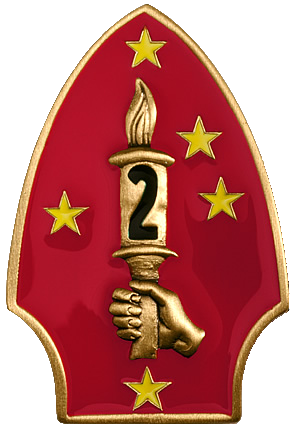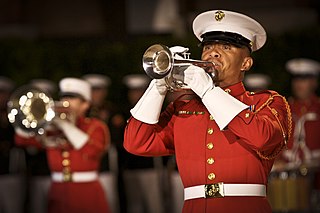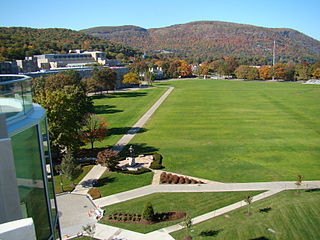
The flag of the United States Marine Corps is the flag used to represent the U.S. Marine Corps, as well as its subsidiary units and formations.

Beating Retreat is a military ceremony dating to 17th-century England and was first used to recall nearby patrolling units to their castle.

The 2nd Marine Division is a division of the United States Marine Corps, which forms the ground combat element of the II Marine Expeditionary Force. The division is based at Marine Corps Base Camp Lejeune, North Carolina and headquartered at Julian C. Smith Hall.

The United States Marine Corps Silent Drill Platoon is a 24-man rifle platoon led by a Captain and Platoon Sergeant of the United States Marine Corps (USMC).

The United States Marine Band is the premier band of the United States Marine Corps. Established by act of Congress on July 11, 1798, it is the oldest of the United States military bands and the oldest professional musical organization in the United States. Today, the Marine Band includes the Marine Chamber Orchestra and Marine Chamber Ensembles.

The United States Marine Drum & Bugle Corps is the drum and bugle corps of the United States Marine Corps. The D&B is now the only full-time active duty drum corps in the United States Armed Forces. As one of many United States military bands, the United States Marine Drum & Bugle Corps consists of 80 active-duty Marines dressed in ceremonial red and white uniforms. The D&B performs martial and popular music.

Public duties are performed by military personnel, and usually have a ceremonial or historic significance rather than an overtly operational role.

Marine Barracks, Washington, D.C. is located at the corner of 8th and I Streets, Southeast in Washington, D.C. Established in 1801, it is a National Historic Landmark, the oldest post in the United States Marine Corps, the official residence of the Commandant of the Marine Corps since 1806, and the main ceremonial grounds of the Corps. It is home to the U.S. Marine Drum and Bugle Corps and the U.S. Marine Band. Barracks Marines conduct ceremonial missions in and around the National Capital Region as well as abroad. They also provide security at designated locations around Washington, D.C. as necessary, and Barracks officers are part of the White House Social Aide Program.

A military tattoo is a performance of music or display of armed forces in general. The term comes from the early 17th-century Dutch phrase doe den tap toe, a signal sounded by drummers or trumpeters to instruct innkeepers near military garrisons to stop serving beer and for soldiers to return to their barracks and is unrelated to the Tahitian origins of an ink tattoo.

Major General Charles Heywood was the ninth Commandant of the Marine Corps. He served as an officer for over 45 years and was the first Marine to reach the rank of major general. During Heywood's term as Commandant, the size of the Corps more than tripled, from 2,175 Marines to 7,810 total.

The Marine Military Academy is a private college preparatory academy located in Harlingen, Texas, US, offering a college preparatory curriculum for boys in grades 7–12 plus one year of post-graduate study. The school was founded in 1965. Its traditions and ideals are inspired by the United States Marine Corps (USMC), but the school is not affiliated with the USMC except through its Junior ROTC program.
Orders to Sentry is the official title of a set of rules governing sentry duty in the United States Armed Forces. While any guard posting has rules that may go without saying, these orders are carefully detailed and particularly stressed in the U.S. Navy, U.S. Marine Corps, and U.S. Coast Guard. Also known as the 11 General Orders, the list is meant to cover any possible scenario a sentry might encounter on duty.

The history of the United States Marine Corps (USMC) begins with the founding of the Continental Marines on 10 November 1775 to conduct ship-to-ship fighting, provide shipboard security and discipline enforcement, and assist in landing forces. Its mission evolved with changing military doctrine and foreign policy of the United States. Owing to the availability of Marine forces at sea, the United States Marine Corps has served in nearly every conflict in United States history. It attained prominence when its theories and practice of amphibious warfare proved prescient, and ultimately formed a cornerstone of U.S. strategy in the Pacific Theater of World War II. By the early 20th century, the Marine Corps would become one of the dominant theorists and practitioners of amphibious warfare. Its ability to rapidly respond on short notice to expeditionary crises has made and continues to make it an important tool for U.S. foreign policy.

The United States Marine Corps (USMC) prescribes several types of military uniform to distinguish its service members from other armed services, depending on the situation.
The Marine Corps Institute, commonly referred to as MCI, developed and maintained a curriculum of Marine Corps education. Subjects included infantry strategy/tactics, leadership skills, MOS qualifications, personal finance, and mathematics. Completion of MCI courses was generally required for promotion to the next Marine enlisted rank.

United States Marine Corps Recruit Training is a 13-week program, including in & out-processing, of recruit training that each recruit must successfully complete in order to serve in the United States Marine Corps.

The Plain is the parade field at the United States Military Academy at West Point, New York. The flat terrain of the Plain is in contrast to the varied and hilly terrain of the remainder of the campus. The Plain rises approximately 150 feet (45 m) above the Hudson River and has been the site of the longest continually occupied U.S. Army garrison in America since 1778. In its early years, the entire academy was located on the Plain and it was used for varying activities ranging from drill and mounted cavalry maneuvers to an encampment site for summer training to a sports venue. Currently, the Plain refers to just the parade field where cadets perform ceremonial parades.

The United States Navy Ceremonial Guard is the official ceremonial unit of the United States Navy. It is responsible for the performance of public duties in the U.S. Navy. The guard is composed of 200+ enlisted navy personnel. It is based at Naval District Washington, Washington Navy Yard, Washington D.C. It is currently led by Commander Alexander McMahon.

The Sunset Parade is a military parade performed by the United States Marine Corps at the Lincoln Memorial on the National Mall in Washington, D.C. It is very loosely based on the Landing Party Manual and is executed on Tuesday evenings in the summer, involving approximately 200 personnel drawn from the garrison of Marine Barracks Washington.




















